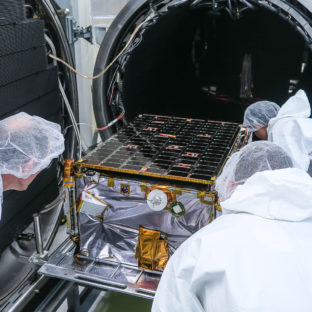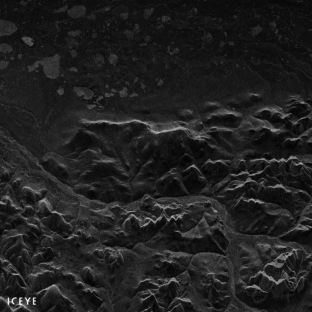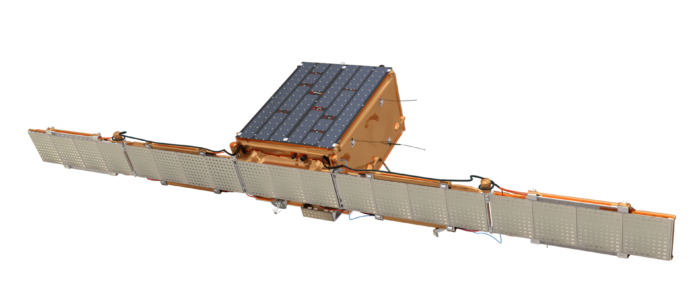Finland Launch Commercial Radar Satellite Services
Through miniaturization of the SAR technology for satellites, the Finnish start-up company, ICEYE, has launched the first micro radar satellite in a constellation, which within a short time can deliver high quality pictures with a response time of six hours and a resolution of three metres.

ICEYE during tests. Note the small dimensions.
The first satellite, launched on 12 January, has already provided the first pictures of very good quality. With one satellite in orbit the resolution is three metres, but the response time is four weeks. With a six- satellite- constellation, the resolution is still three metres; however, the response time will be reduced to six hours.
During 2018 the constellation will consist of three satellites and by the end of 2019, possibly six satellites will be in orbit.
At the conclusion of the initial proof-of-concept missions, ICEYE will launch a constellation of more than 18 SAR-enabled microsatellites to bring reliable high-temporal-resolution imaging to the market. ICEYE’s constellation, once fully deployed, will allow users to accurately image any point on Earth within only a few hours, regardless of weather or darkness. With 18 satellites the radar will monitor every point of the Earth eight times a day.
The success of the launch, distinguishes ICEYE-X1, as the world’s first microsatellite equipped with synthetic-aperture radar (SAR) to ever be deployed in space and as Finland’s very first commercial satellite.
ICEYE-X1 is ICEYE’s initial proof-of-concept microsatellite mission using a SAR sensor. The goal of the mission is to validate in-orbit performance of the satellite and begin operations with select ICEYE customers. Data received from the satellite in space can be used for a wide variety of use cases including monitoring changing sea ice for maritime and environmental uses, tracking marine oil spills and helping to prevent illegal fishing, to name a few examples.
To mitigate the inherent risks associated with rocket launches and to verify specific provider capabilities, ICEYE has opted to launch its three initial missions each through different launch providers. ICEYE’s next launch of a proof-of-concept satellite, ICEYE-X2, is currently indicated by the next launch’s provider to occur during the summer of 2018.
“ICEYE has been committed to enabling better decision making for everyone with Earth observation capabilities, and now through this new SAR data source, we are closer than ever to unlocking that potential across many different industries,” said Rafal Modrzewski, CEO and co-founder of ICEYE in connection with the launch. “I am extremely proud of the ICEYE team who have now, for the first time in the world, opened up the possibilities of the miniaturization of SAR technology. With the support from the Finnish and European communities, Aalto University, Tekes, Horizon 2020, all of our investors, our extremely talented advisors, and so many more who’ve supported us, we have been able to achieve this crucial milestone.”
Throughout 2018, ICEYE has at least two additional satellite missions planned to further develop and demonstrate the capabilities of the company’s SAR technology. ICEYE is a start-up founded in 2012 developing satellites for earth observation. This is a spin-off of Aalto University satellite project with solid venture financing. Iceye’s mission is to revolutionize satellite imaging and situational awareness on a global scale with the fraction of conventional costs.
The first Picture.
 Helsinki, FINLAND – January 17, 2018 – ICEYE, the leader in synthetic-aperture radar (SAR) technology for microsatellites providing expanded access to reliable and timely earth observation data, today published the first radar image obtained with the ICEYE-X1 SAR satellite. The image depicts Noatak National Preserve, Alaska, on Monday Jan. 15, at 21:47 UTC. ICEYE-X1 is the world’s first SAR satellite under 100 kg, launched less than a week ago on Jan. 12, 2018 on ISRO’s PSLV-C40 from Satish Dhawan Space Center in Indi
Helsinki, FINLAND – January 17, 2018 – ICEYE, the leader in synthetic-aperture radar (SAR) technology for microsatellites providing expanded access to reliable and timely earth observation data, today published the first radar image obtained with the ICEYE-X1 SAR satellite. The image depicts Noatak National Preserve, Alaska, on Monday Jan. 15, at 21:47 UTC. ICEYE-X1 is the world’s first SAR satellite under 100 kg, launched less than a week ago on Jan. 12, 2018 on ISRO’s PSLV-C40 from Satish Dhawan Space Center in Indi


